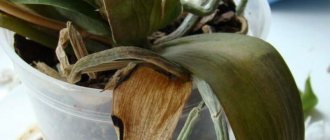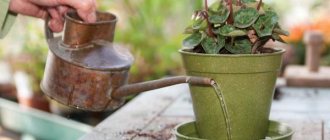Orchids are the most popular indoor flowers that appeared several centuries ago. Their hybrid species can delight with their flowering for a long time and look beautiful during the dormant period.
Flower growers use all possible means to achieve a long period of color for their home “beauties,” but the day comes when the orchid drops its flowers and no longer blooms. What to do when the orchid has faded?
In nature, representatives of the orchid family can produce buds almost all year round, because they are always in comfortable conditions for themselves, but domesticated species are slightly different.
Types of orchids and flowering period:
- Dendrobiums and Cattleyas can bloom 3 times every 12 months, and their arrows live on average 2 weeks.
- The flowering of Miltonia depends on a huge number of factors, so it is difficult to determine when it will stop.
- Cambrias and Cymbidiums delight with their beauty for up to 3 months a year.
- Paphiopedilum and its hybrids can bloom for up to 2 years in a row.
- Phalaenopsis sometimes bear fruit all year round, branching and lengthening the flower stalks.
Flowering period for orchids
Flowering time is specific to each variety. Creating favorable conditions will allow the orchid to grow and bloom for a longer time. What to do with an orchid after flowering at home?
Orchid blossom
Experienced flower growers know that re-blooming can only occur if a number of conditions are met. First (and most important) – the leg must be healthy. The age of the plant is also important. Early flowering can destroy too young plants, which puts the flower at risk of not recovering. It is easy to distinguish between an adult and a young plant: an adult orchid must have at least 5 branches, 7-8 is considered a standard indicator for it.
Important information! It takes less time to process orchids growing strictly vertically than orchids growing to form bushes.
Another factor that guarantees repeated flowering is the presence of regular lighting. By reducing watering and lowering the temperature for several days, it is possible to stimulate the appearance of new flowers. When the buds grow, proper watering is necessary. Spraying is recommended during the heating season. Excessive use of nitrogen supplements negatively affects plant development.
How to care for a flower so that a new peduncle appears?
An adult orchid (1.5-3 years old), with proper care, will constantly delight the owner with another flowering. The basic rules of care are the regular supply of nutrients to the flower, strict adherence to vegetation and dormancy regimes. Any deviation from the required standards leads to depletion and death of the orchid.
How to make orchids bloom again?
In order for the plant to bloom again, you must strictly follow the rules of caring for it:
- The orchid root system is adapted to take an active part in the process of photosynthesis. Therefore, clear plastic pots with plenty of holes for drainage are most suitable. This ensures that the roots receive the required amount of light.
- The optimal daylight hours for phalaenopsis are 10-12 hours. The insufficient amount of light is supplemented with phytolamps. The light should be diffused.
- Direct sunlight is only allowed in the morning or evening. Daytime burning rays are contraindicated; it is necessary to shade the flower.
- Even a small movement of a pot with an orchid can cause stress and affect the growth of the peduncle. If you still have to move the flower, place it with the same side facing the sun.
- The optimal daytime temperature for the full development of an orchid is 22-25 °C, night temperature is 16-18 °C.
- Compliance with watering and drying regimes of the substrate will ensure the development of a healthy root system. Before flowering, watering is increased.
- Orchids are demanding of air humidity. It should be 60% or higher.
- Feedings containing phosphorus and potassium stimulate the formation of flower buds.
- Every year in winter you need to give the plant a break from flowering.
What to do with the peduncle
The orchid has faded, what to do with the arrow: options for care and pruning
You should not cut off the arrow on which the flowers were located. Over time, new shoots may form on the peduncle, and a young flower bud may appear from the shortened stem. If necessary, the peduncle is shortened to a height of 1 cm above the last dormant embryo. This leads to the formation of new lateral arrows. Flowering on a side branch is usually not as pronounced as compared to a branch that has just faded.
Stem pruning
There are three ways to treat flower stems:
- Trimming. Green phalaenopsis inflorescences form new flowers. Patience is important at this stage as they can take 1-3 months to form after the previous flower has dropped. Some gardeners prefer to cut the stems of the peduncle. A series of annoying arrow trimmings are carried out in the spring. To do this, the plant is cut 2-2.5 cm above the dormant bud. For phalaenopsis, the optimal breeding season is summer.
- It is recommended to remove dry dark arrows. This should be done only after the flowers have completely dried. From the wilted stems of the inflorescence, the nutrients accumulated during flowering enter the plant. They are necessary for further recovery and growth. Dried flower buds are cut off at a height of about 2 cm from the base. After a few months, under optimal conditions, the orchids will form new inflorescences. Dormant buds are capable of forming new shoots.
- Premature pruning of orchids delays the recovery period and flowering of phalaenopsis by at least six months. If drying does not spread further along the flower, it is worth cutting off the arrow with flowers onto living tissue. Dormant buds may later bloom. Trimming flower shoots above the buds at a height of 1.5-2 cm will allow you to effectively propagate phalaenopsis.
Additional Information! There is no urgent need to trim the green stalks immediately after flowering.
When and why is an escape left?
- Additional flowering . Dormant buds on the shoot can quickly form into flowers.
- Getting kids . If you immediately remove the peduncle, then you can wait a long time for the babies, almost six months.
- Cuttings . This is one of the popular ways to propagate orchids. Immediately after flowering, without waiting for the peduncle to dry, we cut it and divide it into small cuttings, with a dormant bud on each. We place the cuttings in sand or moss, and remove the protective scale from the bud with a scalpel or blade to speed up its awakening.
Orchid arrow: to trim or not
Rhododendron has faded: what to do next
After the orchid blooms, you can cut off the peduncle. The condition is mandatory for Cumbria, Cymbidium and Oncidium orchid varieties. A larger number of kidneys does not guarantee a positive result. The orchid has faded, what should I do with the arrow? In Miltonia, it is recommended to clean the pedicels “in advance” during the period when they begin to directly wither. There is no need to wait until the flowers fall completely.
Difference between partial and complete removal
Pruning of a house plant is required only when the arrow is dry. If there are still live inflorescences on it that have not bloomed, it is better not to touch them and wait for new flowers to appear. It is important to remember that the plant accumulates nutrients in pseudobulbs. In general, plants with faded stems look unsightly.
Removing the peduncle is easy. After the orchid has faded, it is trimmed with a knife, scissors or pruning shears. Tools must be disinfected first. It is recommended to leave the buds about 1 cm and treat the slices with chopped charcoal or other means. The orchid has faded, what should I do next? Some experts suggest “sealing” areas with natural beeswax.
It is important to know! Most orchids have hollow stems. When watering after removing the pedicels, it is important to be careful, because if water gets inside the stem, this can lead to rotting and fading of wilted orchids.
If there are buds on the cut arrows, they can be used as planting material that is propagated by cuttings.
Partial cutting
Partial reduction of the arrow is one of the possible solutions. The method is best suited for phalaenopsis. Studying the stems will reveal the presence of “dormant buds” in plants, from which “babies” and lateral inflorescences appear. In this case, experienced flower growers cut the stem after it has become dry, but not completely, but at some distance from the buds. The result of flowering is new leaves and aerial roots.
Partial circumcision
Interesting! A dry and cool microclimate will increase the likelihood of bolt formation, while a moist and warm microclimate will promote reproduction.
If a wilted phalaenopsis orchid dries out, its stem will begin to turn yellow. In this case, it is removed to the lowest shoots.
What to do with the stem
Hyacinths have faded: what to do with them next
To figure out what to do with an orchid after flowering at home, it is important to understand what to do with the stem. There is a step-by-step algorithm of actions:
- Trim the sheet along the center line to the very bottom.
- Carefully remove the two halves from the stem with your hands.
- Do not water the orchid for several days. The wound should be dry to prevent destruction of the flower.
Dry and yellowed leaves are removed in the same way. If they are green but dry, you should wait, perhaps their elasticity will return. If they do start to turn yellow, it is important to wait until they are completely dry before cutting them off. Beneath the removed leaves you can find everything from young aerial roots to new shoots that have begun to form. What transplantation algorithm is decided by the florist in relation to local conditions.
How to properly replant an orchid after flowering?
Orchid owners try not to get carried away with replanting. This is usually done every two to three years. The fact is that the process is accompanied by stress for the plant: the loss of flowers inhibits the growth of rhizomes. The date of replanting depends on the type of orchid. Transplantation is done only in the spring.
Orchid transplant
When new shoots appear, lady's slippers, oncidiums and cattleyas are moved to a separate pot (do not wait until they begin to take root). The signal for phalaenopsis transplantation is a fresh tip near the root. If the orchid is rotten, the flower needs saving. Reasons for an emergency transplant may include:
- root rot;
- the appearance of pests;
- degraded substrates (soil);
- The rhizomes do not fit in the pot.
You should know! Hard water (high content of iron and other heavy impurities) accelerates the process of salinization and decomposition of the soil, which negatively affects how the orchid fades.
Why did the orchid quickly fade and the stem turn yellow?
Perhaps the plant needs serious help .
There is a situation when an orchid suddenly drops a large number of flowers or buds in a short time. This could be an indicator :
- Diseases;
- Or pest problems.
Especially in combination with the following symptoms :
- Withered leaves;
- Rotting of any parts of the orchid;
- Insects in the ground or on a flower;
- Plaque, spots on leaves or stems.
Attention! In a weakened or diseased plant, the peduncle is completely removed, and the orchid is treated, depending on the identified problem.
Duration of dormancy after flowering
The orchid rests during the cold season. Caring for the plant during this period has its own characteristics. The watering problem is solved by reducing the number of procedures. The base must dry. The standard rest period between waterings is no more than one and a half weeks. The water is removed. For orchids on the cold side there is a risk of low temperature at the roots, so the drainage device must be high.
Flowers should be kept dry otherwise there is a risk of bacteria and fungi. For thermal insulation, you can place a sheet of foam under the flower pot, or place the plant in a container with a high bottom. It is necessary to promptly identify diseases and pests and apply effective means of combating them. Preventative actions are also necessary.
How long should a flower rest?
An orchid is a unique and unpredictable plant, and each specimen has its own character. Therefore, there is no exact timing of the dormant period after flowering. Rest can last from a month to a year. In many ways, the speed of recovery depends on the quality of care and the microclimate in the room.
Important! In an effort to achieve rapid re-formation of buds, impatient gardeners begin to artificially stimulate the awakening of the plant. As a result of incorrect actions, the plant may not have time to regain its strength and will soon die.
Features of care during the rest period
Most hybrid indoor varieties are not sprayed in winter. Stagnant moisture can cause decomposition. On the other hand, excessively dry air (up to 40% humidity) creates conditions for the appearance of pests. To avoid this misfortune, you should regularly turn on the humidifier. In the future, this will help you understand how to care for your orchid after flowering.
Temperatures from +15 ℃ in the evening to +23 ℃ during the day are considered comfortable. A difference of 5-6 ℃ affects the flowering rate. The temperature is regulated by opening the window at night.
Ventilation is extremely useful, but flowers should not be left in a draft (risk of hypothermia). Orchids love light. The height of the lighting equipment (usually fluorescent) is 20 cm above the flower. Higher than 30 cm is not recommended. The main thing is not to place too strong a spotlight (60 W is enough).
Additional Information! In dim light, the leaves stretch and become dull in color.
In winter, fertilizing is carried out no more than once a month or even less often. At lower ambient temperatures, flowers “digest” nutrients less well and take longer to fertilize, which ultimately can prevent them from blooming.
Caring for orchids during the dormant period and after flowering has its own particularities. Knowing the rules for growing individual varieties, even an inexperienced florist can successfully cope with this task.











